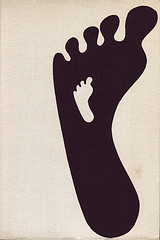Digital ethnography is an increasingly feasible research technique as smartphones decrease in cost and more people carry them around. The photographic capability of smartphones is an important resource in making digital research ubiquitous, giving people the ability to capture images and record observations as they go about their everyday lives, and characterize those observations for ethnographers.
Of course, taking photographs and sharing them online as part of a diary or journal for ethnographic research predates smartphones. Smartphones simply increase the likelihood that an everyday experience is recorded as a representation of the moment in which it occurs. Nevertheless, the video recording capabilities of smartphones afford collaborators an opportunity for representing experience in a manner previously unavailable to ethnographic research.
I’ll discuss the range of implications for ethnography posed by the ubiquitous access to video recording capabilities by ordinary people in another post in the near future. For now, my discussion focuses on how to use video in ethnographic research to inform product/service design.
Video of people using products or services is one of the most challenging data resources used in ethnographic research. Playing and replaying video segments for review is time-consuming and, depending on the number of people involved and the type of activity recorded, difficult to distil into agreed-upon insights.
I recently read several chapters from Sarah Pink’s Visual Interventions: Applied Visual Anthropology, thoroughly enjoying all of them. One chapter in particular though, Video Ethnography Under Industrial Constraints, by Werner Sperschneider, really caught my attention. Werner spells out a technique (the Video Card Game) for analyzing video in design research that I remembered reading about several years ago but, at the time, didn’t really give a lot of thought to.
The Video Card Game draws from the “Happy Families” childrens’ card game, a game in which players collect families of four cards as they ask one another in turn for cards of a particular archetype. The goal of “Happy Families” is to collect a family of four cards, forming a stack. Collecting the most stacks makes you the winner.
Werner provides an overview of how researchers in user-centered design at the Danish industrial manufacturer, Danfoss A/S, initially created the Video Card Game as a method for combining ethnographic and visual research methods using video. Design researchers, Margot Brereton, Jared Donovan, Stephen Viller, at the University of Queensland, as well as Jacob Buur and Astrid Soendergaard, of the University of Southern Denmark, and the University of Aarhus, respectively, also provide case studies of its use.
Family Resemblance and the Video Card Game
The Video Card Game’s design provides a collaborative space of interaction for researchers, designers, and design collaborators to co-create insights for product and service design, using video as a primary source of insight. The rendition of the game offered here refers to it as the Video Card Family Game for the explicit purpose of making it clear that Ludwig Wittgenstein’s concept of family resemblance is a key criteria in the gaming process for deciding to which themes a video card belongs. Using the concept of family resemblance to analyze video enables design researchers to organize, prune, and interpret actions taken in their research with collaborators in the field, providing actionable ideation outcomes.
When playing the Video Card Family Game the key is remembering that, even though the cards give the video a tangible mode of expression, the images remain on relatively small cards, whether on the surface of a table or attached to a poster on the wall. One can imagine an interactive wall display like Microsoft’s Surface that minimizes the legibility problem. Short of such a solution however it is important to keep in mind the spatial limitations imposed by rendering video representations of action onto tangible video cards arranged on tables or walls.
Keep reading if you are curious about how the Video Card Family Game is played in the context of video analysis for design research.
Playing the Video Card Family Game
1.) Prepare for play by breaking an ethnographic video into segments of no more than two minutes each. Select video segments using insights you gain during field observation.
Note: It is important to select video segments in which actions are primarily occurring rather than conversations. You want, predominantly, to see what people do rather than hear what they say. In other words, focus on video where people are involved in physical action.
2.) Select a key frame from each video segment. Create a video card with the image of that key frame at the top of the card, the number of the key frame, a basic title, and a comment area below the picture. Figure 1 shows an example video card.
Note: The number of video cards created from the two-minute segments provides a degree of objectivity in the selection process. Ideally, each game player receives a stack of 10 video cards. Duplicate each stack before beginning play.
(Allocate one hour for steps 3 – 7)
3.) Explain the rules of the game by providing a synopsis of steps 4 – 12.
4.) Provide players with instructional guidance on the difference between observing action in video and interpreting action.
Note: Observations come from descriptions of who is engaged in the action, what they are doing, where they are doing it, when they do it, and how they do. Interpretations involve assertions about why particular people do what they do when and where they do it. At times though, how they do it applies to interpretation when it relates to why the action occurs.
5.) Group the players into pairs and provide each group with duplicate stacks of video cards.
6.) Play the video segments corresponding to each video card in the duplicate stacks provided to each pair of players.
Note: Instruct each game player in the groups to review the video segments together but not to discuss them.
7.) Ask players in each group to take observational notes regarding what happens in the video segment corresponding to a video card. The idea here is for each player to personalize their video cards through writing notes on them, making them tangible research artifacts to handle and use in design discussions.
(Allocate 30 minutes for Step 8)
8.) Ask each pair of players to discuss what they saw in the video segments and arrange their video cards into “families” that share a theme, before placing them on a table. Any theme is appropriate as long as it makes sense for the design focus of the game.
(Allow 1 hour for Steps 9 – 10)
9.) Ask each player to choose a favorite “family” of video cards from the ones they identified with the other player in their pair. Doing so makes that player responsible for relating the design focus to user input as exhibited in the resulting “family” of video cards.
10.) Glue each favorite “family” to a poster and write a heading for the theme it represents. Organize the video segments corresponding to each “family” for easy review.
(Allow 3 – 4 hours for Step 11)
11.) Bring all the players from all the pair groups back together with their posters. Ask each player to describe and show their favorite “family” of video cards and invite other players who think their video cards fit, or resemble, the theme to add them to that family. The game property of the play comes to bear at this step, since the idea of the game is to pass as many cards from your stack to others as possible. The player describing their favorite “family” attempts to avoid further additions to their theme by playing the relevant video segment and explaining why the proposal to add another video card does not fit. No single player has seen all the video segments. Therefore, accepting or rejecting a video card for each theme depends on all the players reviewing the video segment from which the video card proposed for addition is drawn.
(Allow 1 hour for Step 12)
12.) Document the themes by having members of each pair group write a structured description using the following format:
- Describe the theme
- Describe why it belongs in the family you assigned it to
- Provide at least two examples
- Describe the way the action occurs in context
- Describe the way people employ the action in using technology in the context
Posted by Larry R. Irons
Share this post…














I recently stumble on a cool game that would be cool to check out. I have been playing it non stop and find very fun!
Play Morbid Chapter 2